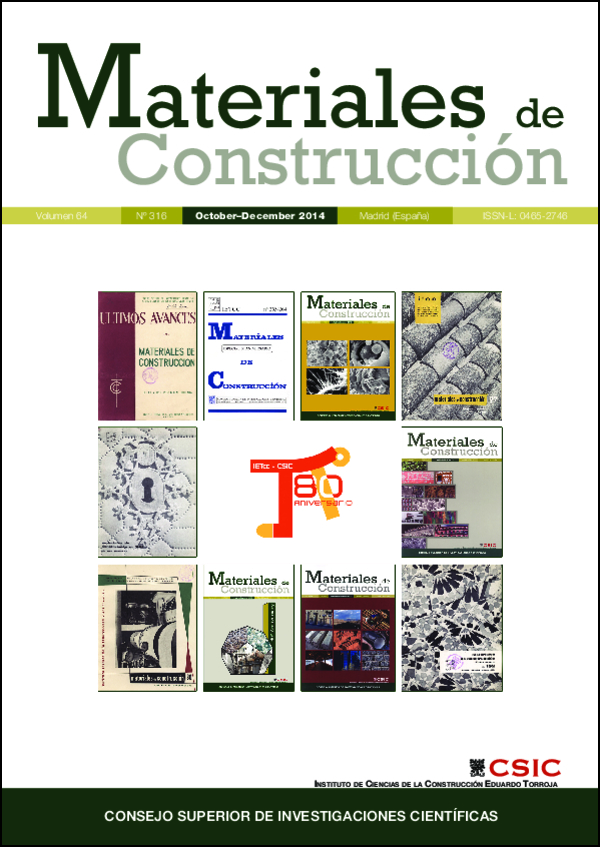Effect of citric acid and the hemihydrate amount on the properties of a calcium sulphoaluminate cement
DOI:
https://doi.org/10.3989/mc.2014.03513Keywords:
Calorimetry, Ettringite, Sulphoaluminate, Citric acidAbstract
The influence of citric acid on the hydration and strength development of a calcium sulphoaluminate cement was investigated. Cement pastes were prepared by mixing calcium sulphoaluminate (C4A3Ŝ) with 15, 20 and 25wt% of hemihydrate (CŜH0.5). Citric acid was added as a retarder at 0 and 0.5wt%. The samples were cured at 20 °C for periods of time from 1 to 28 days to evaluate their compressive strength and to characterize the hydration products by scanning electron microscopy and X-ray diffraction. Calorimetric curves showed that the retarding agent considerably decreases the heat release rate and the quantity of total heat released. The main product after the curing was ettringite (C6AŜ3H32). The morphology of this phase consisted of long and thin needles growing radially on the cement grains. Samples with 15wt% of hemihydrate and 0.5wt% of citric acid developed the highest compressive strength (70 MPa) at 28 days of curing.
Downloads
References
1. Sharp, J.H.; Lawrence, C.D.; Yang, R. (1999) Calcium sulphoaluminate cements – low-energy cements, special cements or what? Adv. Cem. Res., 11 [1], 3–13. http://dx.doi.org/10.1680/adcr.1999.11.1.3
2. Propescu, C.D.; Mountean, M.; Sharp, J.H. (2003) Industrial trial production of low energy belite cement. Cem. Concr. Comp., 25 [7], 689–693. http://dx.doi.org/10.1016/S0958-9465(02)00097-5
3. Juenger, M.C.G.; Winnefeld, F.; Provis, J.L.; Ideker, J.H. (2011) Advances in alternative cementitious binders. Cem. Concr. Res., 41 [12], 1232–1243. http://dx.doi.org/10.1016/j.cemconres.2010.11.012
4. Gartner, E. (2004) Industrially interesting approaches to ''low-CO2'' cements. Cem. Concr. Res., Vol. 34 [9], 1491–1496. http://dx.doi.org/10.1016/j.cemconres.2004.01.021
5. Odler, I. (2000) Special inorganic cements, Ed. Library Binding, Great Britain.
6. Kasselouri, V.; Tsakiridis, P.; Malami, Ch.; Georgali, B.; Alexandridou, C. (1995) A study on the hydration products of non-expansive calcium sulfoaluminate cement. Cem. Concr. Res., 25 [8], 1726–1736. http://dx.doi.org/10.1016/0008-8846(95)00168-9
7. Metha, P.K.; Klein, A. (1965) Formation of Ettringite by Hydration of a System Containing an Anhydrous Calcium Sulfoaluminate. J. Am. Cer. Soc., 48 [8], 435–436. http://dx.doi.org/10.1111/j.1151-2916.1965.tb14786.x
8. Puertas, F.; Blanco, M.T.; Gimenez-Molina, S. (1995) Kinetics of the thermal decomposition of C4A3S^ in air. Cem. Concr. Res., 25 [3], 572–580. http://dx.doi.org/10.1016/0008-8846(95)00046-F
9. Glasser, F.P.; Zhang, L. (2001) High-performance cement matrices based on calcium sulfoaluminate–belite compositions. Cem. Concr. Res., 31 [12], 1881–1886. http://dx.doi.org/10.1016/S0008-8846(01)00649-4
10. Arjunan, P.; Silsbee, M.R.; Roy, D.M. (1999) Sulfoaluminate-belite cement from low-calcium fly ash and sulfur rich and other industrial by-products. Cem. Concr. Res., 29 [8], 1305–1309. http://dx.doi.org/10.1016/S0008-8846(99)00072-1
11. Perá, J.; Ambroise, J. (2004) New applications of calcium sulfoaluminate cement. Cem. Concr. Res., Vol. 34 [4], 671–676. http://dx.doi.org/10.1016/j.cemconres.2003.10.019
12. Sahu, S.; Havlica, J.; Tomková, V.; Majling, J. (1991) Hydration behaviour of sulphoaluminate belite cement in the presence of various calcium sulphates. Thermochimica Acta, 175 [1], 45–52. http://dx.doi.org/10.1016/0040-6031(91)80244-D
13. Winnefeld, F.; Lothenbach, B. (2010) Hydration of calcium sulphoaluminate cements - experimental findings and thermodinamic modeling. Cem. Concr. Res., 40 [1], 1239–1247. http://dx.doi.org/10.1016/j.cemconres.2009.08.014
14. Escalante-Garcia, J.I.; Rios-Escobar, M.; Gorokhovsky, A.; Fuentes, A.F. (2008) Fluorgypsum binders with OPC and PFA additions, strength and reactivity as a function of component proportioning and temperatura, Cem. Concr. Comp., 30 [2] 88–96. http://dx.doi.org/10.1016/j.cemconcomp.2007.05.015
15. Lorprayon, V.; Rossington, D.R. (1981) Early hydration of cement constituents with organic admixtures. Cem. Concr. Res., 11 [2], 267–277. http://dx.doi.org/10.1016/0008-8846(81)90068-5
16. Hewlett, P.C. (2004) Lea's Chemistry of Cement and Concrete 4th Edition, Elsevier, (2004).
17. Tinnea, J.; Young, J.F. (1977) Influence of citric acid on reactions in the system 3CaO-Al2O3-CaSO4·H2O-CaO-H2O. J. Am. Ceram. Soc., 60 [9], 387–389. http://dx.doi.org/10.1111/j.1151-2916.1977.tb15518.x
18. Singh, N.B.; Shing, A.K.; Shing, S.P. (1990) Hydration study of the system Ca3Al2O6-CaSO4·2H2O-Ca(OH)2-H2O with and without citric acid. J. Am. Ceram. Soc., 73 [10], 3063–3068. http://dx.doi.org/10.1111/j.1151-2916.1990.tb06717.x
19. Möschner, G.; Lothenbach, B.; Figi, R.; Kretschmar, R. (2009) Influence of citric acid on the hydration of Portland cement. Cem. Concr. Res., 39 [4], 275–282. http://dx.doi.org/10.1016/j.cemconres.2009.01.005
20. ASTM C-204, Fineness of Hydraulic Cement by Air Permeability Apparatus, 1995 Annual Book of ASTM Standars. Section 4. Construction. Volume 04.01. Cement, Lime, Gypsum.
21. Ramachandran, V.R.; Beaudoin, J.J. (2001) Handbook of Analytical Techniques in Concrete Science and Technologies. Noyes Publications, (2001).
22. Kurdowsky, W.; Nokun-Wzcelik, W. (1995) Calorimetric Studies Of Special Cements. J. Therm. Anal., 45 [10], 923–930. http://dx.doi.org/10.1007/BF02547459
23. Escalante, J.I.; Sharp, J.H. (2000) The effect of temperature on early hydration of Portland cement and blended cements. Adv. Cem. Res., 12 [3], 121–130. http://dx.doi.org/10.1680/adcr.2000.12.3.121
24. Winnefeld, F.; Barlag, S. (2010) Calorimetric and thermogavimetric study on the influence of calcium sulfate on the hydration of ye'elimite. J. Therm. Anal. Calorim., 101 [3], 949–957. http://dx.doi.org/10.1007/s10973-009-0582-6
25. Magallanes-Rivera, R.X.; Escalante-Garcia, J.I.; Gorokhovsky, A. (2009) Hydration reactions and microstructural characteristics of hemihydrate with citric and malic acid, Constr Build Mater, 23 [3] 1298–1305. http://dx.doi.org/10.1016/j.conbuildmat.2008.07.022
26. Quennoz, A.; Scrivener, K.L. (2012) Hydration of C3A–gypsum systems. Cem. Concr. Res., 42 [7], 1032–1041. http://dx.doi.org/10.1016/j.cemconres.2012.04.005
27. Motzet, H.; Pöllmann, H. (1999) Synthesis and characterisation of sulfite-containing AFm phases in the system CaO-Al2O3-SO2-H2O. Cem. Concr. Res., 29 [7], 1005–1011. http://dx.doi.org/10.1016/S0008-8846(99)00082-4
Published
How to Cite
Issue
Section
License
Copyright (c) 2014 Consejo Superior de Investigaciones Científicas (CSIC)

This work is licensed under a Creative Commons Attribution 4.0 International License.
© CSIC. Manuscripts published in both the print and online versions of this journal are the property of the Consejo Superior de Investigaciones Científicas, and quoting this source is a requirement for any partial or full reproduction.
All contents of this electronic edition, except where otherwise noted, are distributed under a Creative Commons Attribution 4.0 International (CC BY 4.0) licence. You may read the basic information and the legal text of the licence. The indication of the CC BY 4.0 licence must be expressly stated in this way when necessary.
Self-archiving in repositories, personal webpages or similar, of any version other than the final version of the work produced by the publisher, is not allowed.
















